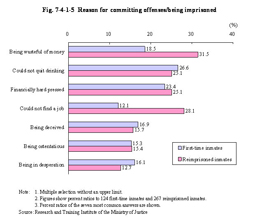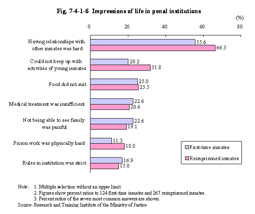| Previous Next Index Image Index Year Selection | |
|
|
5 Consciousness of elderly inmates The survey was conducted during the guidance period that starts two weeks prior to their release, in principle, and in which subjects voluntarily filled out questionnaires. The questionnaire offered multiple choices for each question and asked for disjunctive or redundant answers. Of 607 subjects, 391 answered the questionnaires (response rate of 64.4%). Focusing on the following three questions, characteristic answers by first-time inmates and reimprisoned inmates are described below: [1] causes of their own offenses/imprisonment, [2] impressions of life in penal institutions, and [3] worries after their release. (1) Causes of their own offenses/imprisonment The questionnaire asked for multiple answers to the question “What do you think were the reasons for you committing an offense and being imprisoned? Select applicable reasons from the following”. Fig. 7-4-1-5 shows the seven reasons with the highest ratios of those answered as being applicable to the total number (hereinafter referred to as the “selection rate”) by first-time inmates and reimprisoned inmates. Fig. 7-4-1-5 Reason for committing offenses/being imprisoned Among reimprisoned inmates, “being wasteful of money” (31.5%) was the most common, followed by “could not find a job” (28.1%), “could not quit drinking” (25.1%), and “financially hard pressed” (25.1%), in that order. On the other hand, among first-time inmates, “could not quit drinking” (26.6%) was the most common, followed by “financially hard pressed” (23.4%), and “being wasteful of money” (18.5%), in that order.(2) Impressions of life in penal institutions The questionnaire asked for multiple answers to the question “Looking back on your life in the penal institution, what did you find troublesome?” Fig. 7-4-1-6 shows the seven answers with highest selection rates by first-time inmates and reimprisoned inmates. “Having a relationship with other inmates was hard” was the most common among both first-time inmates (55.6%) and reimprisoned inmates (66.3%), indicating that close contact with other inmates in daily life tends to be stressful. Compared to first-time inmates, the percent ratio of those who answered “could not keep up with the activities of young inmates” (31.8%) and “work was hard physically” was high among reimprisoned inmates. Fig. 7-4-1-6 Impressions of life in penal institutions (3) Worries after releaseThe questionnaire asked for multiple answers to the question “As you think about being released and returning to society, what sort of uncertainties or worries do you have?” Fig. 7-4-1-7 shows the seven answers with highest selection rates by first-time inmates and reimprisoned inmates. The selection rates for “having no money” (34.7% among first-time inmates, 46.4% among reimprisoned inmates) and “having no job” (36.3% among first-time inmates, 43.8% among reimprisoned inmates) were commonly high among both first-time inmates and reimprisoned inmates, indicating that many recognized financial problems to be an urgent issue in their life after release. The selection rates differed among first-time inmates and reimprisoned inmates with “having no one to turn to” (15.3% among first-time inmates, 28.1% among reimprisoned inmates) and “Apologizing to victims” (32.3% among first-time inmates, 8.2% among reimprisoned inmates). This result indicates reimprisoned inmates have more problems such as having no one to turn to after their release than first-time inmates. Fig. 7-4-1-7 Worries after release |


